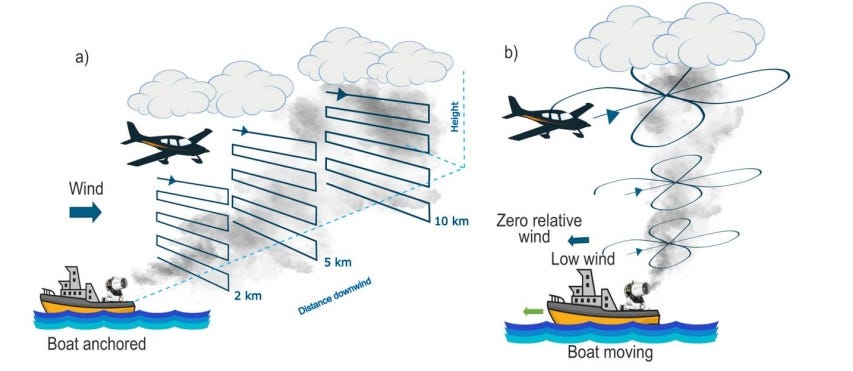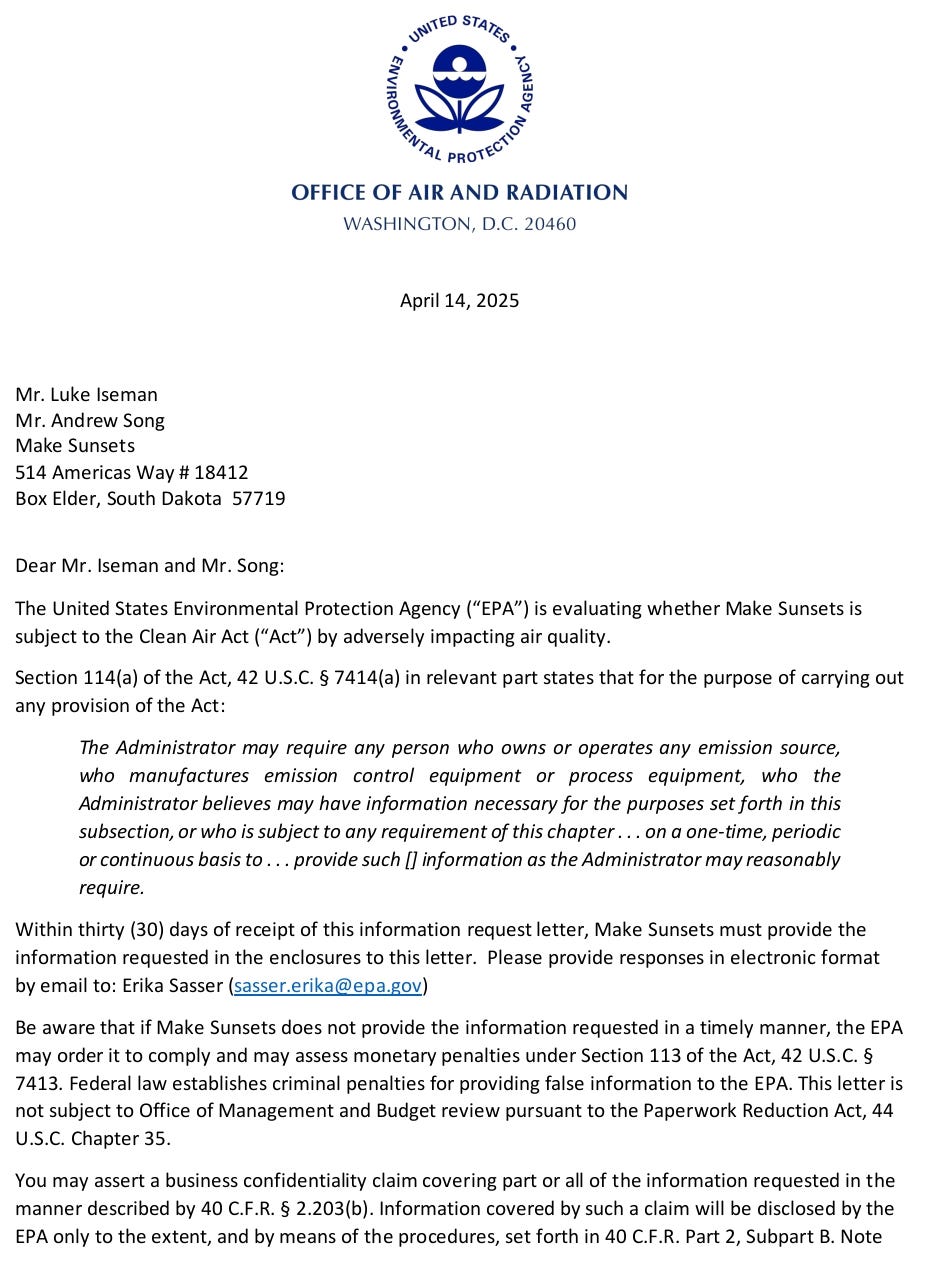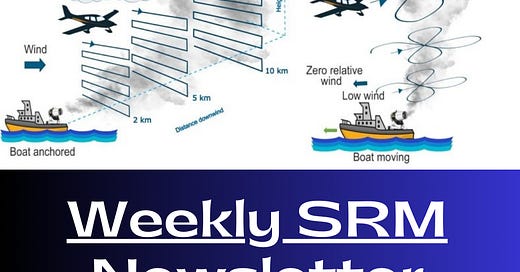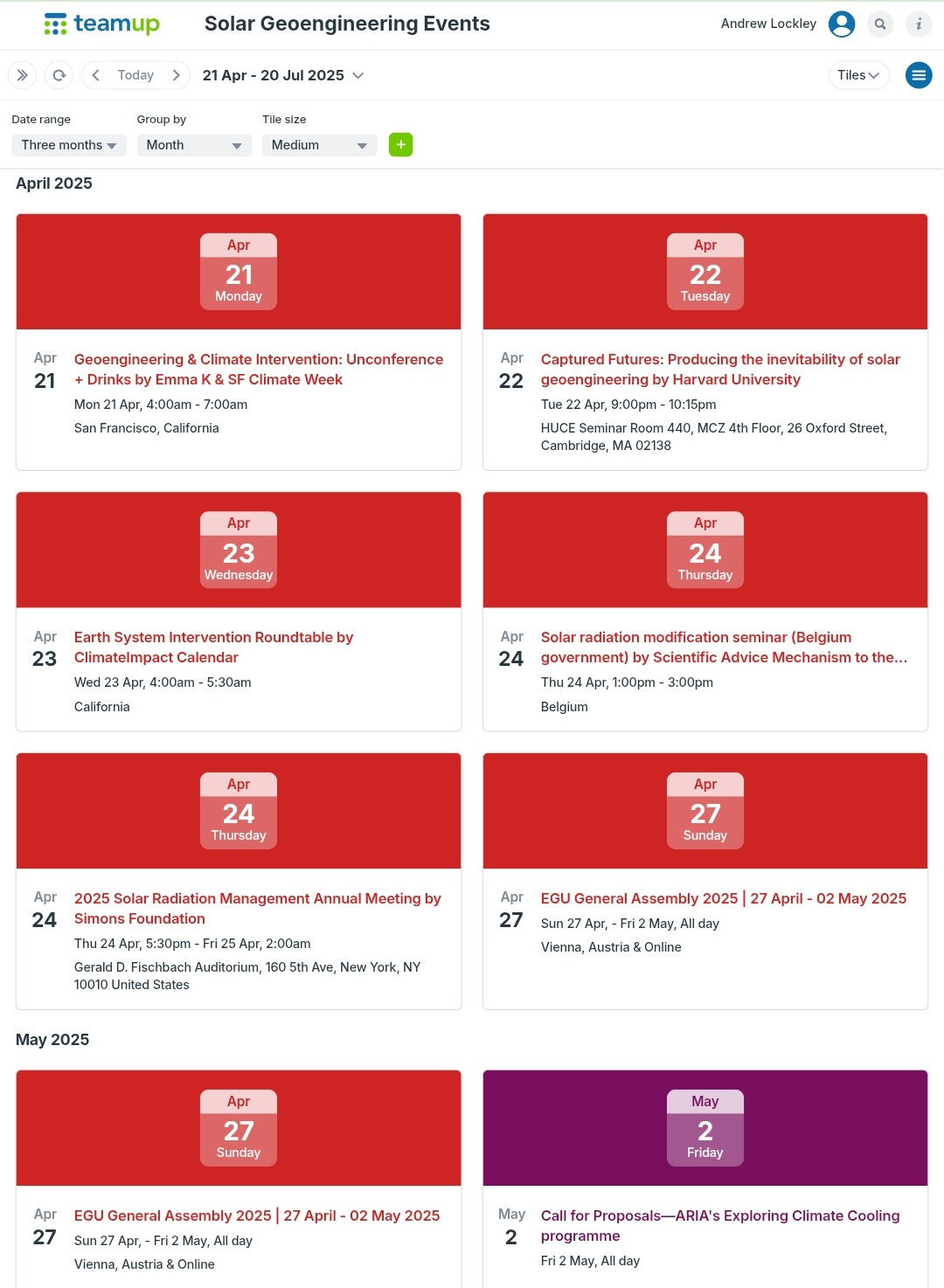Weekly Solar Geoengineering Updates (14 April - 20 April 2025)
Your weekly roundup of SRM updates from past week
1. This Week’s Top SRM Highlights
2. Research Papers
3. Web Posts
4. Thesis
5. Job Opportunity
6. Upcoming Events
7. Podcasts
8. YouTube Videos
9. Deadlines
RESEARCH PAPER: First generation outdoor marine cloud brightening trial increases aerosol concentration at cloud base height (IOP Science)
RESEARCH PAPER: Solar Radiation Management: A History of the Governance and Political Milestones (Royal Society of Chemistry)
DEMAND FOR INFORMATION: EPA Demands Answers from Unregulated Geoengineering Start-Up (Make Sunsets) Launching Sulfur Dioxide into the Air (EPA)
PODCAST: Janos Pasztor: The Most Controversial Fix for Climate Change (Beginner’s Mind)
VIDEO: Solar-Geoengineering Can Stop AMOC Collapse with Douglas MacMartin (Climate Chat)
CALL FOR PROPOSALS: ARIA Exploring Climate Cooling programme | Deadline: 02 May 2025 (ARIA)
Read on to unpack more updates:
Authors: Hernandez Jaramillo, D. C., Harrison, L., Gunner, G., McGrath, A., Junkermann, W., Lieff, W., ... & Harrison, D. P.
Synopsis: This study presents the first field evidence that sea spray aerosols (SSA), generated at the ocean surface for Marine Cloud Brightening (MCB), can reach cloud base height. Conducted over the Great Barrier Reef, aircraft measurements detected SSA plumes from a vessel’s atomisation system at 700–900 m altitudes. While the aerosol output was far below levels needed for full-scale MCB, the findings support the feasibility of future cloud perturbation experiments using surface-generated aerosols.
Authors: McGrath, D.
Synopsis: Current emission trends suggest the 1.5°C and 2°C Paris Agreement targets may be breached, with severe consequences. This review highlights three key climate actions: emissions reduction, greenhouse gas removal (GGR), and solar radiation modification (SRM). While emissions cuts and GGR face scale and tech limits, SRM is gaining attention for its potential short-term impact. All three strategies must be evaluated and governed to address climate risks and meet global warming targets.
Solar Radiation Management: A History of the Governance and Political Milestones
Authors: Jinnah, S., & Dove, Z.
Synopsis: This paper reviews the governance history of solar radiation management (SRM) from 2006 to 2024, challenging the view of SRM as an ungoverned space. It reveals a complex landscape of initiatives, mostly led by Global North countries with concentrated research and governance capacity. The review highlights key mechanisms, political dynamics, and justice concerns, and calls for greater inclusion of Global South voices to shape SRM governance more equitably in the future.
Authors: Koesuma, S., Faqih, A., Hendri, H., Listyarini, J., Kusuma, D. A., Hanggara, A. Z., & Gernowo, R.
Synopsis: This study examines extreme rainfall from tropical cyclones in eastern Indonesia, focusing on Cyclones Seroja, Surigae, and Rai in 2021. Using ERA5 data with GeoMIP bias correction, it evaluates rainfall patterns and compares results under Solar Radiation Management (SRM) scenarios. Findings show decreased rainfall during cyclones under SRM. However, limitations in GeoMIP—like simplified cloud-aerosol interactions—may lead to underestimations of precipitation.
Roadmap Toward a Planetary Sunshade for Space-Based Solar Geoengineering—Preprint
Authors: Matonti, C. L., Coco, M., Cappelletti, C., Chesley, B., Fuglesang, C., Governale, G., Pushparaj, N., Romano, M., Tibert, G., & Wilk, L.
Synopsis: This paper outlines a roadmap for developing a Planetary Sunshade System—a space-based solar geoengineering project to reduce global warming by reflecting sunlight. It details a multi-phase plan, from design and mission planning to launch and in-space assembly. The roadmap assesses system logistics, technical specs, and international coordination, offering a foundation for future space-based climate interventions.

EPA Demands Answers from Unregulated Geoengineering Start-Up (Make Sunsets) Launching Sulfur Dioxide into the Air (EPA)
Scientists have confirmed the diffusion brightening of clouds by stratospheric aerosols (Medium)
Modeling as a tool for predicting coral reef futures (Phys.Org)
CCAN Condemns Reckless Geoengineering Deployment Amid MAKE SUNSETS Controversy (CCAN)
EPA demands info from solar geoengineering company (E&E News)

(EPA)Analysis of solar array power-mass budget for a sunshade concept
Author: Baso, L. (2025). Doctoral dissertation, Politecnico di Torino.
Synopsis: This thesis is part of a broader project by the Colorado School of Mines, Boeing, and the University of Stuttgart to develop a solar umbrella system to reduce Earth's temperature by 1°C. Building on prior studies of feasibility and launch systems, this work focuses on selecting solar cells for a lunar base to support the project. It includes system engineering models and a Power-Mass budget, addressing resource extraction, processing, and panel deployment at Sun-Earth Lagrange Point 1.
"The University of Chicago invites applications for multiple faculty positions (tenured associate or full professor) from scholars who will make significant contributions to Climate Systems Engineering. The University is building a world-leading Climate Systems Engineering initiative with multiple faculty hires addressing solar geoengineering, open-system carbon removal such as enhanced weathering, and interventions to limit loss of glacial ice. We seek individuals who will lead research programs that will produce significant contributions to their field and to this research initiative."
(NEW) Captured Futures: Producing the inevitability of solar geoengineering by Harvard University | 22 April 2025 | Cambridge
Earth System Intervention Roundtable by ClimateImpact Calendar | 22 April 2025 | California
Solar radiation modification seminar (Belgium government) by Scientific Advice Mechanism to the European Commission | 24 April 2025 | Belgium
2025 Solar Radiation Management Annual Meeting by Simons Foundation | 24-25 April 2025 | New York
(NEW) EGU General Assembly 2025 | 27 April - 02 May 2025 | Vienna, Austria & Online
Dimming the sun—The urgent case for geoengineering by MEER | 04 May 2025 | Online
The 2025 Degrees Global Forum | 12-16 May 2025 | Cape Town, South Africa
Fifteenth GeoMIP Workshop by NSF and Quadrature Climate Foundation | 12-16 May, 2025 | Cape Town, South Africa
Consultative Workshop and Science-Policy Dialogue on Solar Radiation Modification by UNEP | 19-20 May 2025 | Switzerland
Artic Repair Conference 2025 by University of Cambridge & Center for Climate Repair | 26-28 June 2025 | Cambridge UK
2025 RFF and Harvard SRM Social Science Research Workshop: Governance in a Fractured World | 04-05 September 2025 | Washington DC
11th WMO Scientific Conference on Weather Modification | 3-7 November 2025 | Pune, India
"To discuss SRM news over the past month, we're joined by Chad Baum, behavioral scientist and Assistant Professor at Aarhus University in Denmark, and Julie Vinders, Lawyer and Senior Research Analyst at Trilateral Research in the UK. We'll talk through the German Environmental Agency's recent policy report on SRM, as well as the Council on Foreign Relations' Climate Realism Initiative, that considers SRM as one of many interventions to "avert catastrophic global climate change". We'll also discuss Julie's article on how the precautionary principle as understood under EU law applies to SRM, and Chad's recent international study of over 30,000 people examining how emotions impact public support for climate interventions."
Janos Pasztor: The Most Controversial Fix for Climate Change | Christian Soschner
“Watch to uncover:
-Why geoengineering may soon become a global necessity—not a fringe idea.
-What governments aren’t telling you about unilateral climate interventions.
-The ethical, political, and scientific minefield behind planetary cooling.
-Why do some scientists say this tech could save millions—and others call it madness.
-What it will take to govern Earth’s thermostat before someone does it alone."
Solar-Geoengineering Can Stop AMOC Collapse with Douglas MacMartin | Climate Chat
"Douglas MacMartin is an Associate Professor in the Sibley School of Mechanical and Aerospace Engineering at Cornell University. His research focuses on Sunlight Reflection Methods (SRM, also known as climate engineering, solar geoengineering, or climate intervention), with the aim of helping to develop the knowledge base necessary to support informed future societal decisions in this challenging and controversial field. He has published extensively on the subject, and in addition to public and academic presentations has provided briefings to the UN Environment Program and testimony to the US Congress, and was a member of the US National Academies panel that made recommendations on both research and governance in March 2021. He received his Ph.D. in Aeronautics and Astronautics from MIT in 1992; previous positions include United Technologies Research Center (1994-2000) and the California Institute of Technology (2000-2015). His research is funded by NSF and by the Cornell Atkinson Center for a Sustainable Future."
"Dr. Ben Bromley shares his research into how cosmic dust might be used as a sun shield to help cool the planet. This is truly cutting-edge science you’ll want to hear about!"
"In this video, I focus on understanding the optical and radiative effects of atmospheric aerosols and clouds with my "Physics Primer 101". This is a complex subject since aerosols can both result in cooling regions of the planet and warming other regions, depending on the specific details.
Important factors include:
-size distribution of the aerosols as a function of altitude
-composition of the aerosols
-shape of the aerosols
-do the aerosols absorb the incoming sunlight, or scatter the sunlight, or both
-lifetime of the aerosols in the troposphere is short, since they are typically rained out within a week
-fraction of the aerosols that form cloud condensation nuclei (CCN)
-fraction of the CCN that form water droplets within clouds
-size of the water droplets within clouds
-relative altitude of clumps or absorbing aerosols versus clumps of scattering aerosols versus existing clouds etc."
(NEW) Call for Proposals—ARIA Exploring Climate Cooling programme | Deadline: Clarification questions by 28 April 2025; Submission deadline: 02 May 2025
Follow us on:
Twitter | Bluesky | YouTube | Substack | Google Group | Podcast 1 | Podcast 2
Support us here:














